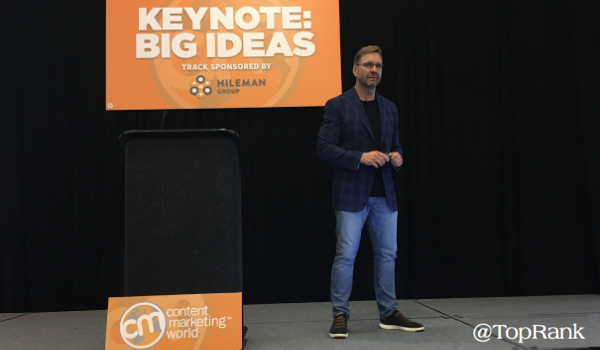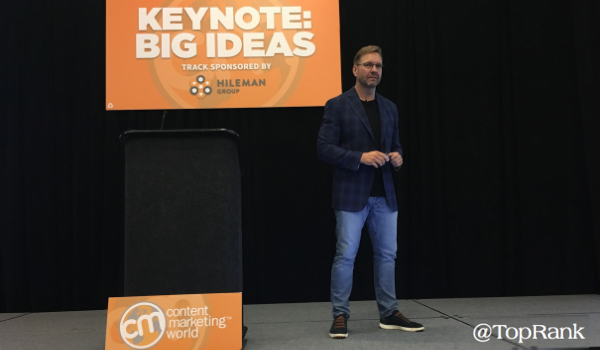
Let’s face it: Too many of us are yo-yo marketers.
We deploy a campaign the way someone might approach a fad diet: With nothing but our initial enthusiasm to keep it going.
And like a fad dieter, we get results… for a little while. Then the campaign runs out of steam and we’re back at square one.
Wouldn’t it be nice if those initial successes could last? If we could go from “fad diet” marketing to lean, mean marketing machines?
At his Content Marketing World 2019 session, TopRank Marketing CEO Lee Odden laid out a blueprint for how to do just that.
Not only is Lee a champion of always-on marketing that gets sustainable results over time, he’s also achieved a dramatic physical transformation in the past year. He’s lost 65 pounds and just finished his first half-marathon.
Turns out, the same discipline and strategy that makes for great content marketing is fantastic for fitness, too. It’s all about consistency and persistency.
Here are Lee’s 10 Exercises for Content Marketing Fitness.
10 Steps to Content Marketing Fitness
#1: Warm Up with Customer Insights
“Know your customer” is a pretty standard motto for marketers. But most of us don’t get deep enough into what those three words really mean. Truly knowing your customer means having insight into:
- Activities: What does their workday look like?
- Pain: What are they suffering from/worried about?
- Goals: What do they wish they could accomplish?
- Influences: Who or what is providing guidance?
To warm up your customer insights, you need to answer all of these questions for each stage of the customer journey, preferably with first hand data.
#2: Strengthen Your Core with Strategy
Before you start creating content, you need to know what that content is meant to accomplish. Most content plans won’t involve jumping straight into driving leads and closing sales.
The first part of your strategy should involve meeting the customer where they are (based on your footwork in step 1), challenging their status quo and inviting a change in perception. Then you can begin the process of capturing leads and driving revenue.
#3: Optimize Your Strategy with KPIs
As you developed your strategy, you had goals in mind: Our content should change people’s mind about X, help them see the benefits of Y, etc. Now you need to put those goals into measurable KPIs with matching metrics, like so:
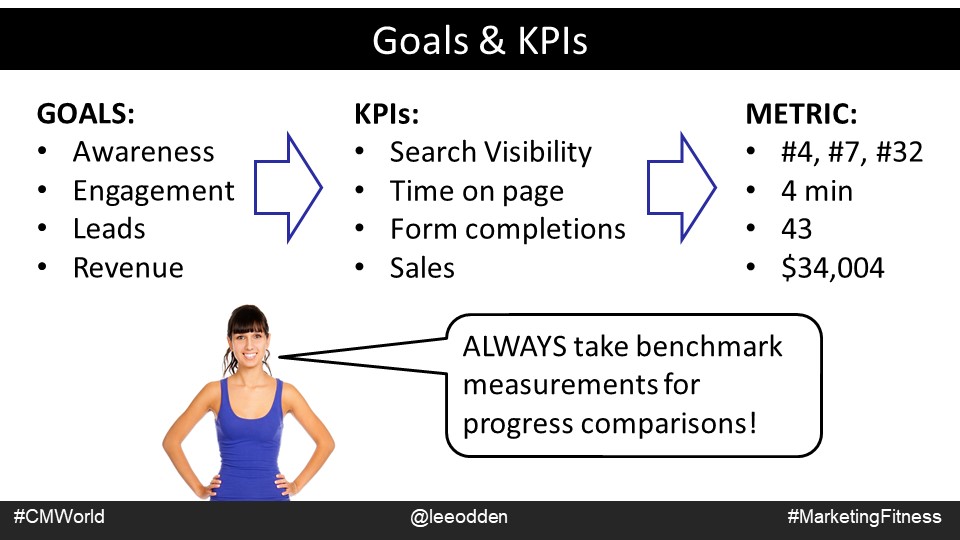
The most important part? Set benchmarks before you start. Without benchmarks, you have nothing to compare your new campaign to.
#4: Create a Powerful Story
This is my favorite part: Take your content strategy and turn it into the story you will tell throughout your campaign.
That means building a bridge of narrative that connects your audience from their current state – their wants, needs, pain points – to your solution. It means helping them solve multiple problems along the way, even problems that have little to do with your offering.
For example, this campaign from our client Prophix ultimately leads their audience to a solution: Using real-time data with their plug-in for PowerPoint. But along the way, it helps finance leaders level up their presentation skills in many other ways, along with advice from influential experts (more on that later).
#5: Optimize Your Content Mix
With your story outline in place, the next step is to create the framework for your content. Lee recommends a hub and spoke model. Anchor content is supported by crosslinked content about secondary topics.
Get creative as you plan your mix: You can include the standard blog posts, of course, but also look at quizzes, infographics, audio and video. Also think about content with built-in amplification, like guest blogs from influencers (more on that in the next point) and posting your own blogs on third-party sites.
6: Boost Quality & Reach with Influencers
For B2B marketing, “influencer” doesn’t mean someone holding up your product in Instagram photos. It’s more about developing relationships with people who are genuinely influential to your target audience, co-creating content with them, and making it easy for them to help promote the content.
Or, as Lee puts it: “People who invest their time to help you make a thing, are generally motivated to help share the thing, to make it successful.”
The planning you’ve done so far will help make sure that your content is aligned both with SEO and with your influencers’ areas of expertise.
#7: Create Powerful Content
As you’re creating content, Lee recommends a hub-and-spoke model. You have a central, substantial asset that addresses search demand and includes influencer contributions. Then you augment that hub with secondary content that further explores side topics (and meets demands expressed in longtail keywords.
For TopRank Marketing, our go-to hub is the “Power Page.” It’s a definitive guide, optimized for search and for humans to read. It’s specific, lengthy, and goes into deep detail. Here’s a wireframe Lee shared:
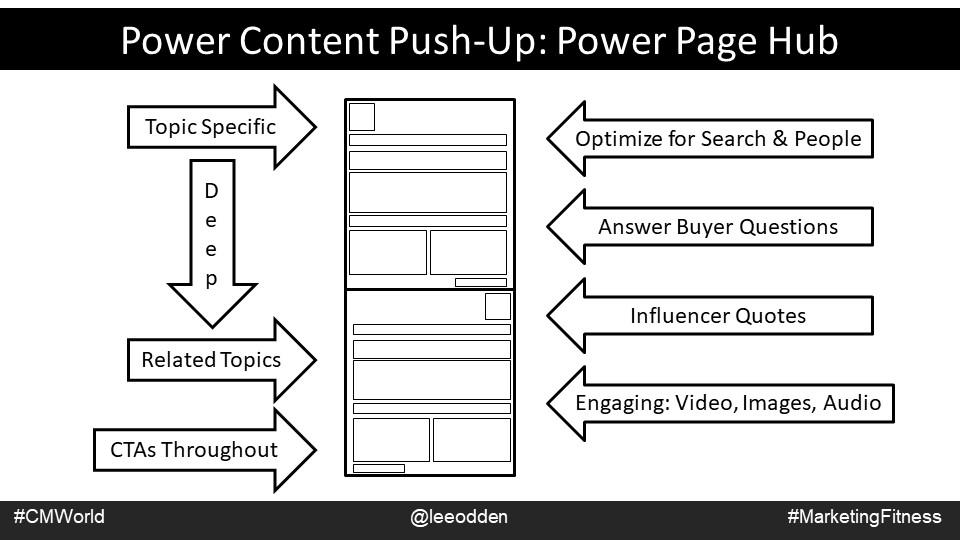
#8: Create Your Content Promotion Timeline
When you’re creating content this great, you can’t just graft on promotion after it’s done. Lee says, “The best time to plan your promotion is when you’re planning the content.” Let’s say it again in bold: The best time to plan your promotion is when you’re planning the content.
When you plan in advance, you can build in repurposing like influencer round-up posts, infographics, even capturing audio interviews instead of written so you can turn them into podcast episodes.
Here’s what a well-rounded promotion timeline might look like:
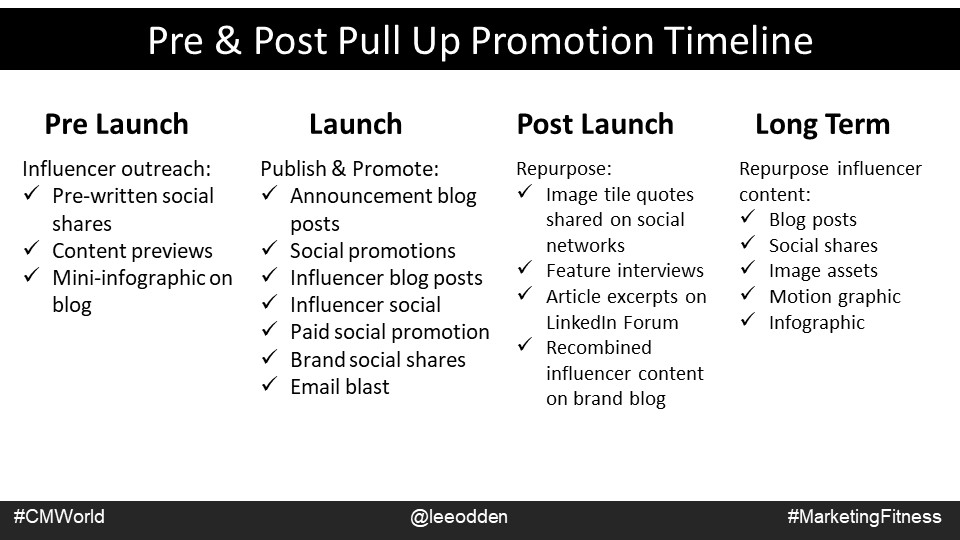
#9: Measure & Optimize
Now we’ve reached the stage that turns all of your effort so far into an ongoing marketing commitment – the kind that breaks free from yo-yo marketing and gets sustainable results.
Instead of publishing, having your initial promotion push, and moving on to the next campaign, keep watching your metrics, make changes based on your observations, and repeat.
Lee points out that we often optimize when content isn’t performing well, but we should also be looking at content that’s performing better than expected. What made that content and promotion mix special? How can we duplicate it? How can we make it even better?
Here are a few metrics to measure:
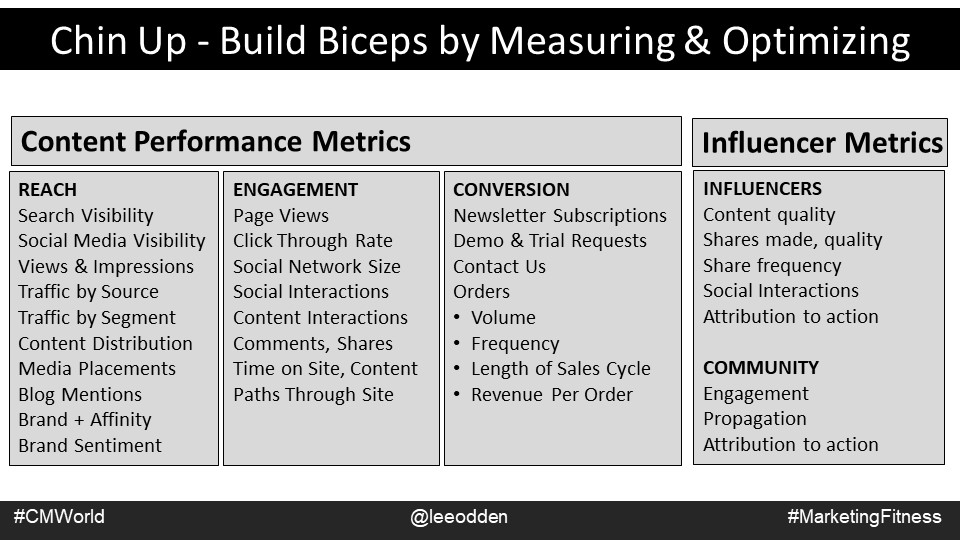
#10: Repurpose with Purpose
Part of the optimization process is getting every bit of juice out of the content you worked so hard creating. If you included repurposing in your strategy at the planning stage, you’re good to go: Turn your interviews into round-up posts, your blog posts into infographics, infographics into motion graphics, etc.
But don’t just do it to make more stuff, Lee says. Rather, repurpose to suit your content to different audiences. For example, audio content as a podcast might appeal to a younger set of decision makers who wouldn’t read a 2,000 word blog post.
Or think about different verticals: Imagine your audience is both IT decision influencers and executive decision makers. With a few cosmetic changes, the same content can be optimized to target each audience individually. As Lee put it, “Personalization is the best kind of repurposing.”
Content Marketing Fitness for the Long Haul
The hardest part of losing weight is keeping from gaining it back. It’s easy to fall into old habits and lose the progress you’ve made. The same is true of marketing. Your biggest challenge isn’t a disinterested audience or a boss who won’t expand your budget – it’s simple human inertia. And the only way to fight it is to commit to a sustained effort, make sure your whole team is on board, and embark on your content fitness journey together.
Need more Content Marketing World in your life? Stay tuned to the TopRank Marketing Blog for more tips, tricks, and live coverage. And follow our team: @leeodden, @NiteWrites, @azeckman, and @toprank on Twitter for real-time insights.
